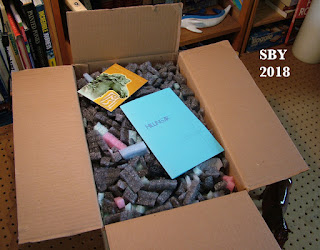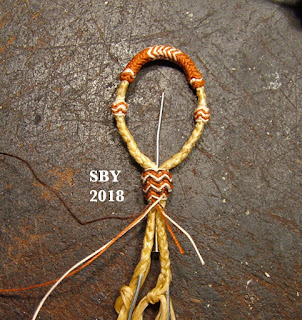It is difficult to create in miniature something you have neither photo nor drawing for. I am proceeding from the memory of a single encounter with a young Appaloosa mare and her rider, and their hackamore (which I fell in love with on the spot). The encounter happened late on a June day in the Black Hills of South Dakota; it was on the road through Roby Canyon, which is in the western edge of the Hills. Although the meeting was short, I felt it was important, and almost immediately afterwards I wrote down some details on the back of the bird list (the usual place for such things). This lean paragraph is my best evidence for what I'm now trying to build.
"Bosal 1/2", Natural w/ dk brn nose, banded heel. Slit-braid hangar [sic], no deco. Fiador light-colored w/ dark fleck, tied w/ wooden beads!! Mecate black, white & gray. Matching hobbles w/ 2 braided connector hangars [sic], w/ banded buttons!"
[Having an ex-pilot in the family, I do tend to spell "hanger" the
airplane way. :) It's hard enough to learn that the equine term for
the headstall for a bosal is not headstall but hanger. : ( The same
ex-pilot is also a military buff, leaving me trying to remember that a
sword's supporting belt and strap is also called a hanger.]
The
bosal was obviously the place to start. And here is where fate
stepped in, in the shape of Ichabad Crane!!! Alas, alack, for 20+ years
my measurements and formulas have been for a true 1:9 model horse, and
my bosal recipe is perfected for:
the Stone ISH. When I started
the bosal for the Roby Canyon Hackamore I was more concerned with the
fact I was going to be putting interweaves in the nosebutton when my
memory clearly told me there were none (
this is the TSII!! showing off fancy braidwork matters), than worried about whether to allow for the turns of the mecate AND the fiador. Of course it would fit.
I got the sidebuttons properly located relative to the eyes.
The pin shank in the middle is holding space for the future heel knot concho's pin.
Finished.
My adventures falling in love with Ichabad/True North, named Dry The Sea (chronicled in the
previous post)
were beside the point. It was only natural to set him on the
tack bench, right? Natural to somehow switch my attention from an
unchosen Trad to this intoxicating bay, so popular, so long desired.
I'd shaped the bosal to him, hadn't I?
Natural to make the fiador for him, with more attention and
size
than I'd ever made a fiador before. It was braided from 6 threads instead of spun from the normal 4.
Below is the fiador tied in a traditional hackamore knot.
This picture (below) shows the mass of thread the wooden bead had to encompass (the 4 strands below the jaw, right near the tip of the out-of-focus strap). It also shows one of the files I used to make the bead with. It turned out beastly hard to get all that mass through the bead. At model scales, Roby's two beads became one.
I made the wooden bead from a
bamboo skewer from a Chinese restaurant, by the way -- bamboo polishes
up in scale better than most woods.
I did research to find how the jaw strap attached - and then chucked it and just cut a larger strap to hold a slit. The full scale Roby hackamore had used a jaw strap, to keep the cheekstraps away from the eyes.
And there you have it:
I'd switched horses in midstream and hadn't realized it.
True North, aka Ichabad Crane, aka Dry The Sea, was truly a much bigger horse.
There wasn't going to be enough room for the mecate.
I should have known.
On a different subject,
Why did this encounter, unusual but not rare, inspire me so? I've seen other riders while we were out birdwatching. I've got the whole world of Internet images to draw upon. I've got years of experience as to what training hackamores look like (which was of great use when it came to buckling down to this piece). Perhaps it was the wooden beads, obviously an easy way out of tying those bothersome fiador knots -- they looked so cute. Perhaps it was the color of the mecate; I'd never before made one with gray. Perhaps it was the stunning beauty of the hobbles combined with the headgear -- I'd never before seen braided connectors used to hang hobbles with, let alone matching colored ones. (In the paragraph, 'banded' means "having contrasting braided interweave rings.") Duh.
Perhaps it was the beauty of the horse. She was a stunner, a blue roan with a patchy snowflake hip blanket and plenty of spots. Spirited, barely under control, young (of course), great conformation. Perhaps it was the friendliness of the rider; she let me approach and pet and gawk. There was a second rider, on a pale palomino, but these two merely threw the App into relief. Geo and I had been noting the tracks of two shod horses on the dirt road and knew they were ahead of us, but only chance had caused them to turn around before we did. The moment I saw them I transitioned from the birder's best public-relations (you have to evolve this if you birdwatch long enough) to the heart of the tackmaker, well knowing what I was seeing. "Rosie" the mare rolled her eyes at me. The rider, however, complimented my hat three times. : )
 |
| Image from California Classics via Google |
Why would a supposedly-Trad-scale model horse be so large? One might as well ask why one's artistic work expands when one's spirit does. This isn't the place for such weighty questions. I'll settle for measuring Dry The Sea. He appears to be 6 5/8" at the withers, which translates to <oh, this is shocking! My math works out at very close to 1:9: 1:9.05 !!>
<Try it yourself: Divide 6.625 into 60, the inches of a fifteen-hand horse>
I'm supposed to be deciding whether to make another bosal, bigger this time, for the horse I've so clearly let sweep me away. Spluttering -- there's water in my seas yet -- I can only say this will take more time. I want to be working on
mecates right now, and I've started. I'm pleased to say I dyed some thread last night, and this is what it looked like:
Just that amount of thread perfectly used up the dropperful of rubbing alcohol I'd started with. No leftovers. I like the imperfect effect of home-dyeing; I think it much more natural, more true to real horsehair, in this case gray horsehair.
Stay tuned while I spin. Mecates usually take a week, but we'll just see what happens.






























